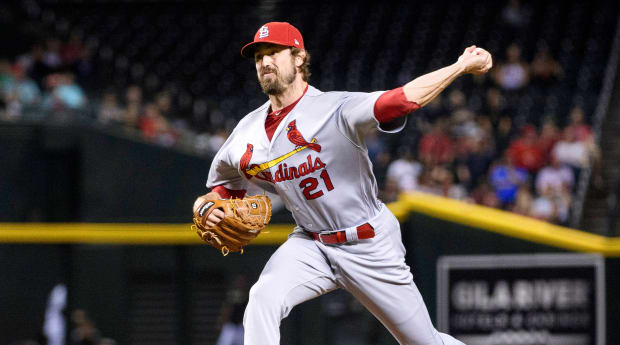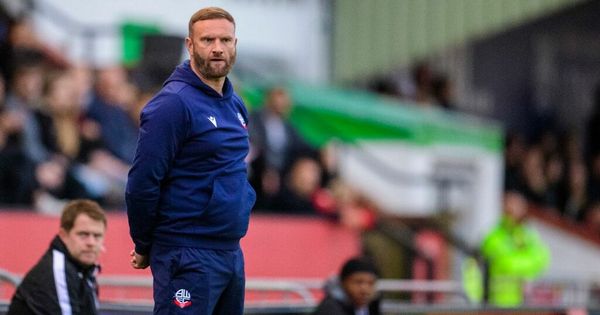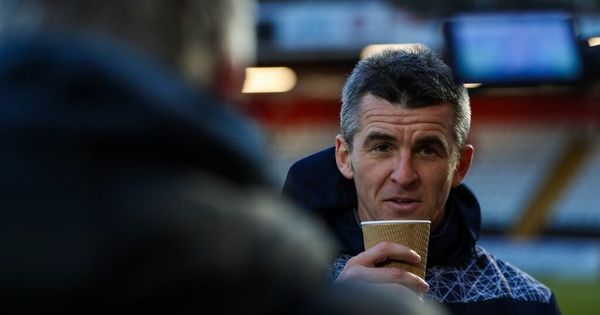It’s now been more than two months since the start of the MLB lockout. The league announced last week that spring training games would be delayed, as had long been expected, and the clock is ticking down to Feb. 28—the unofficial deadline for the two sides to reach an agreement without cutting into the season or pushing back Opening Day. Bargaining sessions have been held intermittently since the first week of January, but with one week left to get a deal done to play a full season, the two sides are expected to meet multiple times in the coming days in Jupiter, Fla.
Before Monday’s meeting, Sports Illustrated spoke with relief pitcher Andrew Miller, one of the eight players on the union’s executive subcommittee, to discuss how baseball got here, what he thinks are the stakes of the negotiations and why all of this matters to him.

Jennifer Stewart/USA TODAY Sports
Sports Illustrated: This seems like it might be a big week. We’re quickly coming up on Feb. 28. How do you view the lockout as it stands right now?
Andrew Miller: I think, unfortunately, MLB was very clear that it was an effort to essentially put pressure on us. We don’t have to be in a lockout. I think that’s a tactic on their end. We could be in spring training right now. We could be playing games and still working on the next CBA. So it’s one of those deals where it’s out of our control, and it kind of is what it is. Certainly, you talk about missing games, and our desire is to play baseball games. It always has been. It came up in 2020 with the COVID-19 issue, but at the same time, we have to be careful about signing a CBA that is good for us and good for the game, and getting to that point is important as well. So we have to balance those two.
SI: Is there anything you think has been misunderstood in how this is playing out publicly?
AM: Hopefully by now, people have been beaten to death with the point that the lockout is an owner-instituted action or a league-instituted action. But for me, I think, there’s a lot of people doing great work on what the issues are and what they really boil down to, and if you dig deep enough, you should hopefully start to gather that all of these pieces kind of move in tandem, and economics is the big issue that seems to hold these deals up. And sometimes it’ll be portrayed as one issue, as the union looking out for a particular class of player, whether that’s the young guys or the old guys or the guys that make a lot of money or the guys in the middle class, or whatever it is, and the reality is, everything kind of works together. Currently, we’re in a system where things aren’t working as well as they should, and how we got to that point is certainly a separate debate, but right now we’re in a place where the game isn’t functioning the way it should. Careers are getting shorter. The average earnings for a player are going down, and yet the industry is growing like crazy. So this is our chance to kind of correct some of that. I believe that teams are operating much differently they were even five, or especially 10, years ago. And this is our chance to kind of adapt the economic system to reflect the way that players are being valued and the way teams are operating.
SI: Going off of that, you were also on the committee in 2016, the last time baseball negotiated a CBA, and it seems like there’s just been growing dissatisfaction with how things have been operating since then. Did anything come out of that deal that you didn’t expect?
AM: I think that when that deal was done, you heard a lot of “status quo,” was the way it was described. I think there was an expectation that the way the system was operating would continue that way, and we found out pretty quickly in the next couple of free-agent classes, that wasn’t going to be the case. And whether that was teams all starting to fall into groupthink and starting to value players in the same way, or we can call it exploiting loopholes in the system. You know, that’s something that you could say that maybe we didn’t have the foresight on, and of course, we’d like to have a crystal ball and know how things are going to play out. But a lot of these issues—certainly there’s the money aspect, but also, we’ve found that a lot of the way the game is operating isn’t the best for the fans or the players. It’s the competition issues that have arisen. The value of tanking and being open about it is something that needs to be corrected. We have a chance to do that through various efforts, whether that’s coming up with a way to make the draft a little bit less predictable, and [limiting] the ability to stockpile prospects and the ability to delay service time—all of these things are issues that we think need to be addressed because teams seem to be taking full advantage of them and not having concern for putting the most competitive product on the field.
SI: Big picture, I think there’s this perception that this is a critical juncture for MLB—with these big questions about on-field product and popularity with younger generations and how you ensure the welfare of the game. And some of those discussions are really old, but how do you see all of these subjects that you’re talking about at the table as fitting into that?
AM: Yeah. It’s a game that certainly all the players love. I hope the other side can say the same in this conversation. But it’s definitely a concern. I grew up loving this game; I want my kids to do the same. I have an 8-year-old son, and I want him to have the same passion for baseball that I do. And I do worry a little bit that maybe we’re forgetting that those are the long-term fans—that if you can grab them when they're young, they can be fans for a long, long time. And there’s a lot of issues about growing the game, I know we hear about blackouts, we hear about the time of games, we hear about the length of play and all of that, but they’re all little pieces that probably need to move a little bit, and we need to visualize the right way to get to them. I think tanking is something you’ve probably heard a lot from us. It’s horrible to tell your fans before the season even starts that you’re not going to compete for a while. That’s not putting a good product on the field. Who wants to go watch a game when ownership has told you that they’re not going to try? And for multiple years, in a lot of cases. I think there are ways that, unfortunately, we have to kind of save them from themselves and convince them. Because the players go out there, and they try to win, every pitch, every at-bat, every game, and to be a player on a team that’s been told that winning isn’t important, it’s an issue. So if we can correct some of that stuff through little things in the CBA—or, I don’t know if I want to call them little things, but through the CBA, through these negotiations, then we need to do so.
SI: Does anything stand out to you as the biggest issue left on the table?
AM: No, I don’t think there’s one issue. Like I said, it seems like, from my perspective—and certainly, you can see it in the proposals we’ve made—we think a lot of things need to change. I think it’s just more—there’s no silver bullet, there’s no magic bullet, to go out and say, O.K., if we can just get this one piece right, everything else will fall into place. It would be nice if it were that simple and both sides could agree to that, and we could move on. But there are a lot of pieces that we feel need to be adjusted and moved and a lot of our positions are really just asking for them to grow in a similar way that the game has. Because the balance can get a little bit out of whack, and it can throw off some of these competitive issues. And yes, again, I think a lot of times, it gets portrayed as purely a money issue, but when we see players not get a chance to establish themselves—if I look back on my career, I wonder how it would play out if I was in the current climate. It’s just all these little pieces, I guess, are the way I would have to put it. There’s not one thing that’s, O.K., if we agree to this, we'll get a deal done pretty much immediately afterward.
SI: In terms of the players you represent—there are hundreds and hundreds of guys in the union, it’s a really broad spectrum of what they’re being paid and how long their careers can be and how teams are using options on them. What does it look like to try to represent a group that big with that many different experiences?
AM: It’s 1,200 guys. I think the number fluctuates when we have offseasons and free agency and stuff, but yeah, it’s 1,200 players that absolutely come from different backgrounds that have different priorities, they’re at different points in their careers, they have different earning potentials. And I think it’s just educating everybody on why this piece may not appear to affect them, why it does or why it’s important for the group to have this position taken. I think we’ve done a really good job of communicating with everybody and letting them understand the reason behind our positions. But it’d be pretty easy to go through and look at the big picture and see that we’re trying to represent everybody the best we can. We’re trying to represent the group and the sport as a whole. And, you know, it can be challenging. Certainly, there are factions of players that maybe have one idea—and to kind of sit down with them and explain why we’re making the moves we are, why we’re looking for changes where we are, is something I think we’ve done a really good job of. Most of the time, it’s pretty easy to convince guys that we have a lot of logic behind what we’re doing.
SI: Logistically, what does building solidarity look like in a group this big—what does that take?
AM: I think a lot of it happened pretty organically, in the sense that we saw [free agency] not work the way we wanted, and guys were rightfully upset. So I think that would be probably the first place I would describe how we got to where we are. In 2016, obviously, we didn’t have the anger and the desire to change the system that we do now. And that was just really a result of watching everything unfold. We talk about it in locker rooms. Everybody that works out in groups in the offseason, everybody that has friends that stay in touch, whether that’s through text or whatever—shoot, guys that go on vacation together and stuff in the offseason. So it just happens. And the agents are certainly a source for where players get a lot of their information, too. Even if you’re not actually going through it, your agent may have other players that are seeing issues within the system and how it’s affecting them, and they pass that along. It’s just a natural thing. I think that if things are running and operating in a much smoother fashion, we probably don’t have this genuine desire from a group this large to move things into correct issues.
Sign up to get the Five-Tool Newsletter in your inbox every week during the MLB offseason.
SI: Along those lines, what did it mean to experience 2020, when the pandemic brought in this unexpected round of negotiations a year before the CBA expired?
AM: Obviously, COVID-19 is an unfortunate issue. I think from the perspective of our union—gathering that solidarity and gaining trust in the people that are guiding us and understanding the moves that we’re making and the moves that the league is making, it was huge. There was a big debate about how many games we could play, and there’s still a grievance outstanding on that, and we think we could have played more games. That’s important to us. The league clearly seemed to find basically what was the most profitable number of games for them to play. When that truth kind of came out, and when we, in a sense, called their bluff on that and put our foot down for what we thought was right and saw their motive was literally to play 60 games—I think hopefully that taught a lot of our guys what was going on, and where we were at and why we had to stand together and why we had to make these choices that at the time seemed pretty tough. That seemed like the right thing to do.
SI: Historically, this is the strongest union in pro sports. That came from a lot of work in the 1970s and ’80s, and there were lockouts and strikes, but now we’re at a point where this is the first big fight in a generation—a lot of players right now weren’t even born for the last work stoppage, in ’94. I’m curious about whether that history feels like it carries weight to guys today.
AM: It does. I think certainly as time goes on—maybe we lose an appreciation, you kind of forget what was fought for. But there is a lot of great history out there. It’s passed down. We have a lot of coaches and staff members that went through that, so they can help us appreciate that, and as guys get involved, we have a lot of people on the union staff that went through it, and they can tell those war stories of what they went through and what they accomplished in doing so for us and why we have a lot of the things we have and the appreciation we should have for them. That gets passed down. I hope guys are absorbing everything they can, what’s written and as they’re told about it because I think it’s a pretty incredible story. It’s a pretty incredible accomplishment—what this union’s done over the years. And you’re right, I mean, it might truly be multiple generations of players that have gone without having to see some of these fights. We don’t want to be the generation to have an opportunity and to miss it, to mess it up because the people before us have done such a great job. And, again, you know, this is our chance to maybe correct some wrongs. We only get it—the way our deals are generally set up—every five years. So this is important to us, making sure we pass that along.
SI: Going off of that, what motivated you to be on the executive committee and give your time to this?
AM: It just kind of happened. I became a rep when I was with the Marlins and started to get an appreciation for what our union did—even the little pieces, something like a team maybe not correctly compensating a guy for coming up and down, and getting to know people in the union because as the rep, you had to make the phone call to find out who was the source to answer your question. We’d have a guy come and ask about their pension, and you’ve got to know who to call for that. And learning that and making those connections and just finding that, you know, it's pretty important—all the little pieces, the checks and balances and what’s been written into the collective bargaining agreements, the value they have. That, and then I would say just, on a selfish level, I find it pretty fascinating: the business side of it, what’s going on and the history. And trying to do my part as a player to, again, pass along a deal that’s as good as the one I found, or better.
SI: Finally, what’s your response to fans who are saying, I’m tired of this, figure it out?










